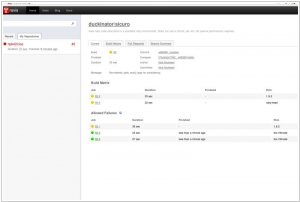Codeship vs Travis CI
May 29, 2023 | Author: Michael Stromann
10

Codeship is a free hosted Continuous Delivery Service that integrates with GitHub and Bitbucket. A simple push to your repository runs your automated tests and configured deployments on our powerful machines. From a simple deployment to Heroku to complex Deployment Pipelines for your large infrastructure, all can be set up with ease.
15

Travis CI is a hosted continuous integration service. It is integrated with GitHub and offers first class support for multiple programming languages. Travis CI's build environment provides different runtimes for different languages, for instance multiple versions of Ruby, PHP, Node.js. It also comes preinstalled with a variety of data stores and common tools like message brokers.
Codeship and Travis CI are both popular CI/CD platforms, but they differ in several key aspects.
Codeship is a cloud-based CI/CD platform that focuses on simplicity and ease of use. It offers a straightforward setup process and integrates well with popular version control systems like GitHub and Bitbucket. Codeship provides a clean and intuitive user interface, making it easy for developers to configure and manage their build and deployment pipelines. It supports parallel testing, allowing for faster feedback cycles, and provides built-in environment options for different programming languages and frameworks. Codeship also offers integrations with popular cloud platforms for easy deployment.
Travis CI, on the other hand, is an open-source CI/CD platform that offers both cloud-based and self-hosted options. It provides a high degree of customization and configurability, allowing developers to define complex build and deployment workflows. Travis CI is known for its extensive integration capabilities, supporting a wide range of version control systems, cloud platforms, and programming languages. It offers a rich plugin ecosystem and allows developers to customize their CI/CD pipelines to meet specific requirements. Travis CI also provides parallel and distributed builds, as well as built-in environment options for different programming languages and frameworks.
One key difference between Codeship and Travis CI is the level of customization and flexibility. Codeship focuses on simplicity and ease of use, providing a streamlined experience with fewer configuration options. Travis CI, being an open-source platform, offers more flexibility and customization possibilities, making it suitable for complex projects and specific requirements.
See also: Top 10 Continuous Integration tools
Codeship is a cloud-based CI/CD platform that focuses on simplicity and ease of use. It offers a straightforward setup process and integrates well with popular version control systems like GitHub and Bitbucket. Codeship provides a clean and intuitive user interface, making it easy for developers to configure and manage their build and deployment pipelines. It supports parallel testing, allowing for faster feedback cycles, and provides built-in environment options for different programming languages and frameworks. Codeship also offers integrations with popular cloud platforms for easy deployment.
Travis CI, on the other hand, is an open-source CI/CD platform that offers both cloud-based and self-hosted options. It provides a high degree of customization and configurability, allowing developers to define complex build and deployment workflows. Travis CI is known for its extensive integration capabilities, supporting a wide range of version control systems, cloud platforms, and programming languages. It offers a rich plugin ecosystem and allows developers to customize their CI/CD pipelines to meet specific requirements. Travis CI also provides parallel and distributed builds, as well as built-in environment options for different programming languages and frameworks.
One key difference between Codeship and Travis CI is the level of customization and flexibility. Codeship focuses on simplicity and ease of use, providing a streamlined experience with fewer configuration options. Travis CI, being an open-source platform, offers more flexibility and customization possibilities, making it suitable for complex projects and specific requirements.
See also: Top 10 Continuous Integration tools


